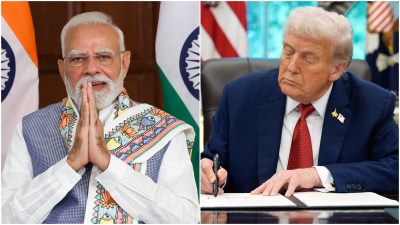 Naveen Munjal, managing director, Hero Electric. (Photo: Facebook @Naveen Munjal)
Naveen Munjal, managing director, Hero Electric. (Photo: Facebook @Naveen Munjal)
Even as the government is working on policies for transition towards a $5 trillion economy, Naveen Munjal, MD, Hero Electric Vehicles, told The Indian Express that the Centre needs to iron out some challenges and get a right mix of measures in the forthcoming Budget. Stating that the goal of $5 trillion is very good, he said the government needs to figure out with stakeholders the key things that need to be done to achieve the same. Excerpts:
What are the challenges for the $5 trillion economy goal?
There are many challenges, but we also have to set ourselves very strong goals, that’s why we can achieve them. If you look, banking reforms are happening, and there are reforms in logistics, transportation sector, infrastructure requirements, the automotive sector, exports and taxation. There are a number of challenges which exist right now. But I met the Finance Minister this morning. As you are hearing also, there are a number of changes that are being done to reach the $5 trillion.

Are we seeing the progress on ground?
There are some issues. In our sector of electric vehicles, the intent is there. The government is talking on the need to go 100 per cent or convert to electric because of fuel and environmental reasons, but the policies are not strong enough. Right now, there are some gaps. There is talk of supporting the higher end of the vehicles, as there is a push for Make in India. But the fact is that if you are targeting that segment, you may not get volumes. I think there should be support for the mass (segment) and along with phase wise implementation on increasing localisation and then the industry will evolve. In terms of the government expenditure, it will still be the same, but you speed up the whole thing.
Story continues below this ad
What were your suggestions to the Finance Minister in the pre-Budget consultations?
When we look at mobility, what we are looking at is that you have to innovate, go into new processes, technology etc. and have to move away from oil dependency, as much as we possibly can. We have to go for zero pollution because at the end of the day, if we look at urban pollution, 70 per cent of the urban pollution is vehicular. Country-wide, when we look at it, it’s different, but urban (areas) are where the problem is. 12 out of 15 most polluted cities in the world are in India. Also, we know that 75 per cent of oil is imported. So, the quicker we convert, the better it is. As for two-wheelers, 76 per cent of the vehicles are in that category, consuming 60 per cent of the oil and producing 30 per cent of the pollution. The quicker you start shifting these vehicles on to newer technologies and on to zero emitting technologies, the better it is for the country.
But hasn’t there been a delay on this?
The government’s intent is there and that’s why they came out with the policies, FAME I and now FAME II. There is a feeling that if you have an equally performing vehicle, only then a consumer will convert. However, that’s not the case. I think that if it’s an equal performance vehicle, electric is going to be expensive. Any new technology is going to be more expensive, the petroleum and diesel sector is now a 100 year-old technology.
So, the new technology will come, it will go through an adoption curve and one can decide if one wants to switch to it or not. The government will have to look at two-wheelers to start with and has to look at mass segment. Demand creation has to be there and then supply will follow.
Is slowdown a worry?
See, it’s a very good idea to have a goal. $5 trillion is very good to have. Now, you have to figure out with the stakeholders about some key things that need to be done and how they need to be done. Various ministries are discussing and listening patiently. They are absorbing the issues, and hopefully they will get resolved.

 Naveen Munjal, managing director, Hero Electric. (Photo: Facebook @Naveen Munjal)
Naveen Munjal, managing director, Hero Electric. (Photo: Facebook @Naveen Munjal)





























